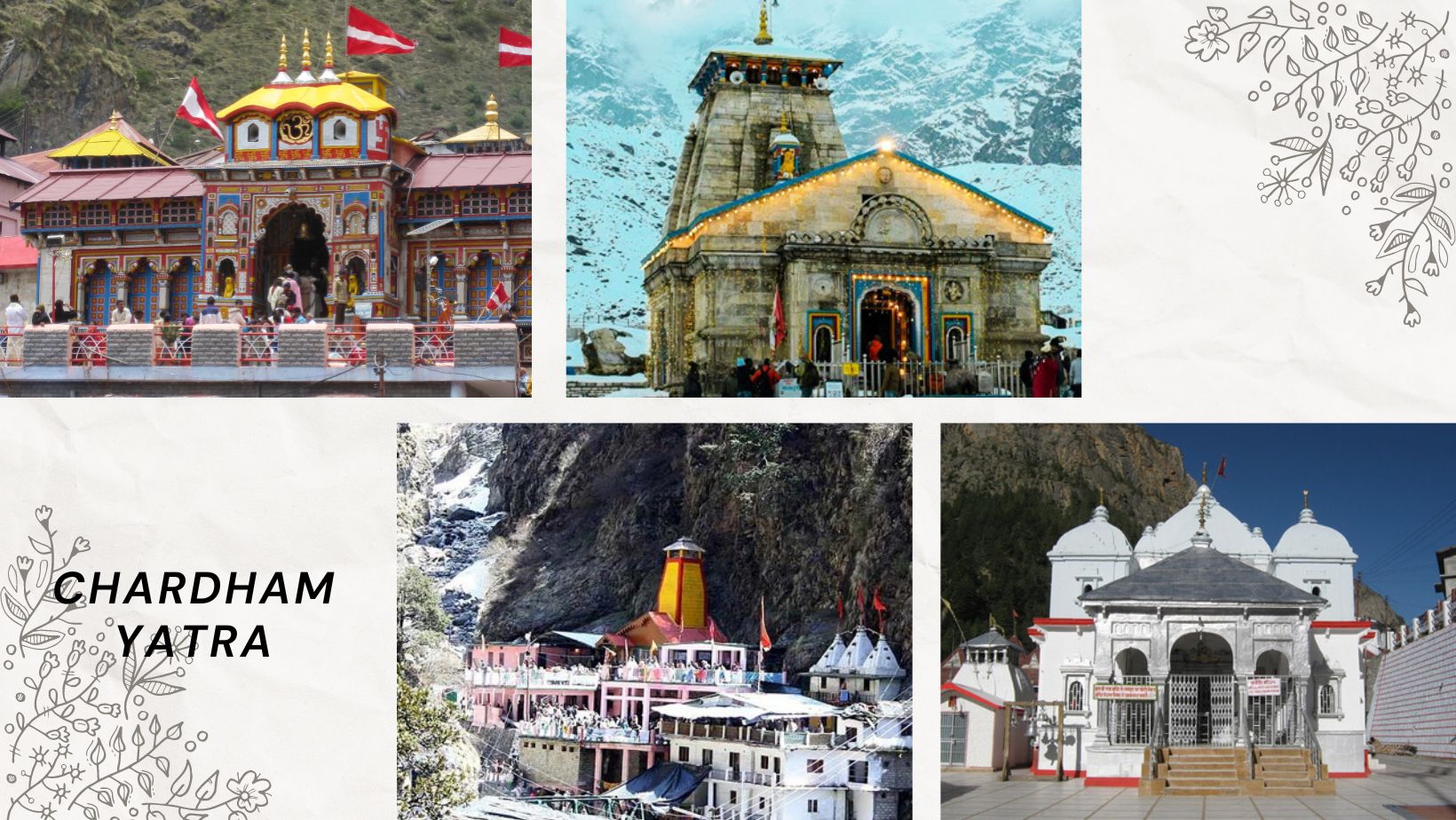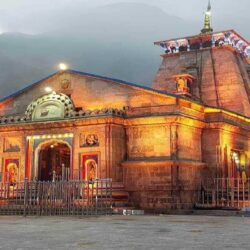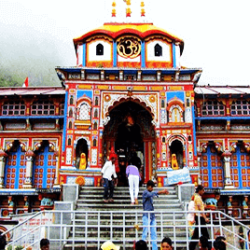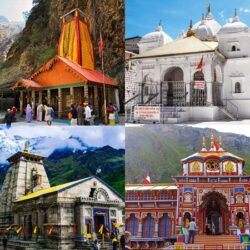Description
Chardham Yatra 2024
The Chardham Yatra is a highly significant pilgrimage tour for Hindus, which takes you to four sacred shrines in Uttarakhand – Yamunotri, Gangotri, Kedarnath, and Badrinath. If you’re planning to embark on the Chardham Yatra in 2024, here’s what you need to know:
Duration: The duration of the Chardham Yatra usually ranges from 10-12 days, depending on the itinerary you choose.
Best Time to Visit: The Chardham Yatra 2024 is open from 10 May to November, and the best time to visit is between May to June and September to November. The weather during these months is pleasant and comfortable for travel, with clear skies and moderate temperatures.
Itinerary: The itinerary for the Chardham Yatra typically starts from Haridwar, with visits to the four shrines in the following order – Yamunotri, Gangotri, Kedarnath, and Badrinath. Some itineraries may include additional spiritual and religious sites in the region, such as Haridwar, Rishikesh, and Joshimath.
Accommodation: There are plenty of accommodation options available along the Chardham Yatra route, ranging from budget-friendly lodges to luxurious resorts. Many tour operators also offer comfortable accommodation options as part of their tour packages.
Transportation: The Chardham Yatra can be completed by road or helicopter, depending on your preference and budget. Road transport is usually provided by buses, jeeps, or private cars. Helicopter services are also available for those who want to complete the yatra in a shorter time frame or avoid the long travel times by road.
Permits: To embark on the Chardham Yatra, you will need to obtain necessary permits and registrations from the Uttarakhand government. These permits are usually arranged by tour operators as part of their tour packages.
Conclusion: The Chardham Yatra is a significant pilgrimage tour for Hindus, offering a unique opportunity to explore the spiritual and natural beauty of Uttarakhand. Whether you choose to travel by road or helicopter, it’s essential to plan your trip in advance and book your accommodation and transportation well ahead of time.
Chardham Yatra 2024 |
|
|---|---|
| Tour Name: | Chardham Yatra 2024 |
| Tour Duration: | 11Nights / 12days |
| Destinations: | Delhi – Haridwar -Barkot – Yamunotri -Uttarkashi- Gangotri- Guptkashi- Kedarnath- Badrinath- Joshimath- Rudraprayag- Rishikesh. |
| Tour Price: | 28,000/- Per Person+5%GST(Min- 6 Person) |
Itinerary
Day 01: Delhi – Haridwar
Arrival at the Airport / railway station meet and assist by ITT executive and later to drive to Haridwar, on arrival transfer to your Hotel. Visit Har-ki-Pauri for Ganga Aarti in evening. Back to your hotel, Night halt.
Haridwar : Haridwar, lying at the feet of Shiva’s hills, i.e., Shivaliks, in the Haridwar district of Uttaranchal Pradesh, is a doorway. Suryavanshi prince Bhagirath performed penance here to salvage the souls of his ancestors who had perished due to the curse of sage Kapila. The penance was answered and the river Ganga trickled forth forms Lord Shiva’s locks and its bountiful water revived the sixty thousand sons of king Sagara. In the traditional of Bhagirath, devout Hindus stand in the sacred waters here, praying for salvation of their departed elder. It is doorway to the sources of the Ganga and the Yamuna, 3000 to 4500 meters up into the snowy ranges of the central Himalayas . The ‘Aarti’ worship of the Ganga after sunset and the floating ‘dia’ (lamp) is a moving ritual.
Day 02: Haridwar – Barkot
Drive to Barkot via Dehradun & Mussoorie. Enroute visit Kempty Fall and others later drive straight to your Hotel for night halt.
Day 03: Barkot – Yamunotri – Barkot
Drive to Hanuman Chatti, for Janki chatti (It helps to reduce the trek upto 8 kms), trek start from here to Yamunotri (6kms). Either by walk or by horse or by Doli at own cost. Arr. Yamunotri, One can cook rice by packing it in a cloth and dipping it in the hot water of the hot kund. Pilgrims take this cooked rice home as “Prasad”. Here near the temple “Pooja” can be offered to Divya Shila, after taking bath in Jamunabai Kund’s warn water and having “Darshan” of pious “Yamunaji” returning to Hanumanchatti. Later drive back to Barkot. Overnight stay at Hotel.
Hanuman Chatti: The confluence of Hanuman Ganga & Yamuna River.
Yamunotri Temple: Maharani Gularia of Jaipur built the temple in the 19th Century. It was destroyed twice in the present century and rebuilt again.
Surya Kund: There are a Number of thermal springs in the vicinity of the temple, which flows into numerous pools. The most important of these is Surya Kund.
Divya Shila: A rock pillar, worshipped before entering the Yamunotri Temple.
Day 04: Barkot – Utttarkashi
Drive to Uttarkashi on arrival Check in the Hotel, Later visit Vishwanath Temple .Night Halt.
Uttarkashi: Situated at the bank of river Bhagirathi. The temple of Lord Vishwanath is located here where a massive iron trident is erected. The other important temples situated here are Annapurna Devi Temple, Ekadash Rudra, Bhairav, Gyaneshwar and Goddess Kuteti Devi.
Day 05: Uttarkashi – Gangotri – Uttarkashi
We proceed to Gangotri (3048 mts), enroute we enjoy picturesque Harsil village, Bhagirathi River and the most magnificent view of the Himalayas . After Gangotri Darshan we return to Uttarkashi. Overnight stay at Uttarkashi.
Gangotri Temple: The temple, constructed by the Gorkha General Amar Singh Thapa in the 18th Century, is situated on the right bank of Bhagirathi.
Submerged Shivling: Submerged in the river, this natural rock Shivling is the place where, according to mythology Lord Shiva sat when he received the Ganga in his matted lock. It is visible in winter months when water level decreases.
Kedar Ganga Sangam: Around 100 Yards from the Ganga Temple flows the river Kedar Ganga. Starting from the Kedar Valley, this river meets the Bhagirathi on its left bank.
Day 06:Uttarkashi- Guptkashi
Early morning, drive to Guptkashi .On Arrival Check in Hotel, night halt.
Day 07: Guptkashi – Kedarnath
Morning drive to Sonprayag, Trek start from Sonprayag to Kedarnath (3584 mts) on foot or on by pony / Doli. Tour members should carry personal medicines, heavy woolen, tolietteries and clothes for an overnight halt at Kedarnath. Check in Hotel. Later visit Kedarnath Temple. Later back to Guptakashi. Night halt.
Gaurikund: At a distance of 5kms from Sonprayag and at an altitude of 1982 meters, one can take bath in the hot water pond here and visit the Gauri Temple. This is the place where Goddess Parvathi meditated to attain Lord Shiva. It is the base for a trek to Kedarnath.
Kedarnath: The Kedarnath shrine, one of the 12 jyotirlingas of Lord Shiva, is a scenic spot situated, against the backdrop of the majestic Kedarnath range. Kedar is another name of Lord Shiva, the protector and the destroyer. According to legend, the Pandavas after having won over the Kaurava in the Kurukshetra war, felt guilty of having killed their own brothers and sought the blessings of Lord Shiva for redemption. He eluded them repeatedly and while fleeing took refuge at Kedarnath in the form of a bull. On being followed he dived into the ground, leaving his hump on the surface. The remaining portions of Lord Shiva appeared at four other places and are worshipped there as his manifestations. The arms appeared at Tungnath, the face at Rudranath, the belly at Madhmaheshwar and his locks (hair) with head at Kalpeshwar. Kedarnath and the four above-mentioned shrines are treated as Panch Kedar.
Day 08: Kedarnath- Guptkashi
Morning take darshan at Shree Kedarnath Ji, later back to Guptakashi by Trek. Overnight stay.
Day 09: Guptkashi – Badrinath
Drive to Badrinath via Joshimath. Check in Hotel. Later at evening visit Badrinath Temple for Aarti. Overnight stay. Badrinath one of the ‘Four Dhams’ is one of the most celebrated pilgrimage spots of the country and is situated at an elevation of 3,133 meters, guarded on either side by the two mountain ranges known as Nar & Narayan with the towering Neelkanth Peak providing a splendid backdrop. This revered spot was once carpeted with wild berries. Thus the place got the name “Badri van”, meaning “forest of berries”.
Tapt Kund : Natural thermal springs on the bank of the river Alaknanda, where it is customary to bathe before entering the Badrinath temple.
Narad Kund : A recess in the river, near Tapt Kund, forming a pool from where the Badrinath idol was recovered.
Brahama Kapal : A flat platform on the bank of river Alaknanda. Hindus perform proppitiating rites for their deceased ancestors.
Sheshnetra : 1.5kms. away is a boulder having an impression of the legendary serpent, better known as the Sheshnag’s eye.
Charanpaduka : 3kms. away is a beautiful meadow where the footprint of Lord Vishnu is seen on a boulder.
Mata Murty Temple : Devoted to the mother of Sri Badrinathji. Other important temples include Sesh Netra Temple , Urvashi Temple and Charanpaduka.
Mana Village : Inhabited by an Indo-Mongolian tribe, it is the last Indian village before Tibet .
Vasundhara : As the name suggests, vasundhara is a magnificent water fall. This place is 5 kms. from Badrinath out of which 2 kms. is motorable upto Mana.
Bhim Pul: On the other side of Mana village, a massive rock forming a natural bridge, lies over the roaring Saraswati river. It presents a spectacular view of water thundering down through the narrow passage under the rock and is believed to have been placed there by Bhim, the second eldest among the five Pandava brothers.
Vyas Gufa (cave) : Near Mana Village, this is a rock-cave where Ved Vyas is believed to have composed the Mahabharata and the pauranic commentaries.
Day 10: Badrinath – Joshimath – Rudraprayag
Early morning, pilgrims after having a bath in the Taptkund have the Darshan of Badrivishal. Brahamakamal is significant for Pinddan Shraddh of ancestors (Pitrus). There are other interesting sightseeing spot like Mana, Vyas Gufa, Maatamoorti, Charanpaduka, Bhimkund and the “Mukh” of the Saraswati River . Just within the three kms of Badrinathjee. Later drive back to Rudraprayag via Joshimath. Check in Hotel.
Joshimath is situated on the slopes above the confluence of Alaknanda and Dhauliganga. Of the four ‘Maths’ established by Adi Shankaracharya, Joshimath is in the Badrinath to Joshimath and installed in the temple for people to worship. There are many temples in the township most important is the temple of Nir Singh in commotion of Lord Vishnu. The left arm of this deity is with time and the popular belief holds that the day the the arm completely withers Badrinath valley will cease to exist and the Gods will transfer the residence into the neighboring Niti Valley at Bhavishya Badri. Joshimath is connected by regular bus service to Rishikesh, Haridwar, Badrinath and many other centres in the region.
Day 11: Rudraprayag – Rishikesh- Haridwar
Morning drive back to Rishikesh. Check in Hotel. Later visit local sightseeing of Rishikesh. Overnight stay.Rishikesh, the ‘place of sages’ is a celebrated spiritual town on the bank of Ganga and is surrounded by Shivalik range of the Himalayas on three sides. It is said that when Raibhya Rishi did hard penances, God appeared by the name of ” Hrishikesh ” and this area hence firth came to be known as Rishikesh. Temples & Sight Seeing – Laxman Jhulla, Ram Jhulla, Triveni Ghat, Bharat Mandir, Ashram, Parmarth Ashram.
Day 12: Haridwar – Delhi
Drive back to Delhi . On Arr. Delhi, transfer to Railway Station / Airport.
Price
Call for Best Deal: +91 9870240354
Hotels Details:
Call for Best Deal: +91 9870240354
Inclusions
- Pick up and drop from airport/railway/bus station.
- Accommodation on double/twin sharing basis.
- All breakfast included at hotels.
- All transfers and sightseeing by private A/C vehicle.
- Driver’s bata, toll, parking, road tax, fuel charges All applicable taxes.
Exclusion
- Service Tax – 5% GST Extra.
- Any air/bus/rail fare Any other meals not mentioned in package inclusions.
- Any other destination not mentioned in itinerary.
- Any personal expenses such as laundry, room service, mini bar, telephone etc.
- Guide charges/boating charges/entrance fees for any sightseeing
- Any services or activity charges other than those included in inclusions.
- Supplementary cost for festival period, long weekend or peak season .
Chardham Yatra 2024 FAQs
Q1: What is the Chardham Yatra?
A1: The Chardham Yatra is a pilgrimage tour in India that covers four sacred Hindu sites: Yamunotri, Gangotri, Kedarnath, and Badrinath. It is believed that undertaking this spiritual journey can cleanse one’s sins and lead to salvation.
Q2: When does the Chardham Yatra take place in 2024?
A2: The Chardham Yatra typically takes place from April/May to October/November, depending on the Hindu calendar and weather conditions. The exact dates for the Chardham Yatra 2024 are subject to announcement closer to the travel season. It’s advisable to check with the tour operators or authorities for the specific dates.
Q3: What are the four sacred sites included in the Chardham Yatra?
A3: The four sacred sites included in the Chardham Yatra are:
- Yamunotri: The source of the Yamuna River and home to the Yamunotri Temple.
- Gangotri: The origin of the Ganges River and site of the Gangotri Temple.
- Kedarnath: The abode of Lord Shiva and home to the Kedarnath Temple.
- Badrinath: The residence of Lord Vishnu and site of the Badrinath Temple.
These sites are located in the Uttarakhand region of India and are considered highly sacred by Hindus.
Q4: How long does the Chardham Yatra take?
A4: The duration of the Chardham Yatra can vary depending on the chosen itinerary and mode of transportation. It typically takes around 10 to 12 days to complete the entire yatra, including travel and stay at each of the four sacred sites. However, the duration can be customized based on individual preferences and time constraints.
Q5: What are the modes of transportation available for the Chardham Yatra?
A5: The Chardham Yatra can be undertaken by various modes of transportation, including:
- Road: Many pilgrims choose to travel by road in buses, cars, or taxis to reach the sacred sites.
- Helicopter: Helicopter services are available for convenient and time-saving travel between the sites.
- Trekking: Some adventurous pilgrims prefer to trek through the scenic routes to reach the temples.
The mode of transportation can be selected based on personal preferences, time availability, and physical fitness.
Q6: Are there any age restrictions or fitness requirements for the Chardham Yatra?
A6: There are no specific age restrictions for the Chardham Yatra. However, the journey involves trekking and can be physically demanding, especially at higher altitudes. It’s advisable to assess your own health and consult with a medical professional before embarking on the yatra. It’s also recommended to start with a proper fitness regimen and carry essential medications, if required.
Q7: Are accommodations provided during the Chardham Yatra?
A7: Yes, accommodations are typically provided during the Chardham Yatra. There are various options available, including hotels, guesthouses, dharamshalas (pilgrims’ rest houses), and tented camps. The level of comfort and facilities may vary depending on the package and the chosen accommodation. It’s recommended to check the details of the package for information on the type and quality of accommodations provided.
Q8: Is the Chardham Yatra suitable for solo travelers?
A8: Yes, the Chardham Yatra is suitable for solo travelers. Many pilgrims undertake the yatra individually and join group tours or avail of the services provided by tour operators. However, it’s important to ensure personal safety and take necessary precautions while traveling alone. It’s advisable to join a trusted tour operator or travel with experienced guides.
Q9: Are there any medical facilities available during the Chardham Yatra?
A9: Yes, there are medical facilities available during the Chardham Yatra. The pilgrimage sites have medical centers and hospitals to provide basic healthcare services. However, it’s advisable to carry necessary medications, a first aid kit, and any prescribed medications specific to your needs. It’s also recommended to have travel insurance that covers medical emergencies. In case of any health concerns, seek immediate medical attention and inform your tour guide or tour operator.
Q10: How can I book the Chardham Yatra 2024?
A10: To book the Chardham Yatra 2024, you can follow these steps:
- Research and select a reputable tour operator or travel agency that specializes in the Chardham Yatra.
- Contact the tour operator through their website, email, or phone to inquire about the available packages and itineraries.
- Discuss your preferences, including travel dates, mode of transportation, accommodations, and any specific requirements.
- Confirm the booking by providing the necessary details and making the required payment.
- Obtain the necessary travel documents, such as permits and identity proofs, as advised by the tour operator.
- Prepare for the yatra by packing appropriate clothing, essential items, and medications.
- Follow the instructions provided by the tour operator and enjoy the spiritual journey of the Chardham Yatra.
It’s recommended to book well in advance to secure your preferred dates and ensure a smooth and hassle-free experience.






